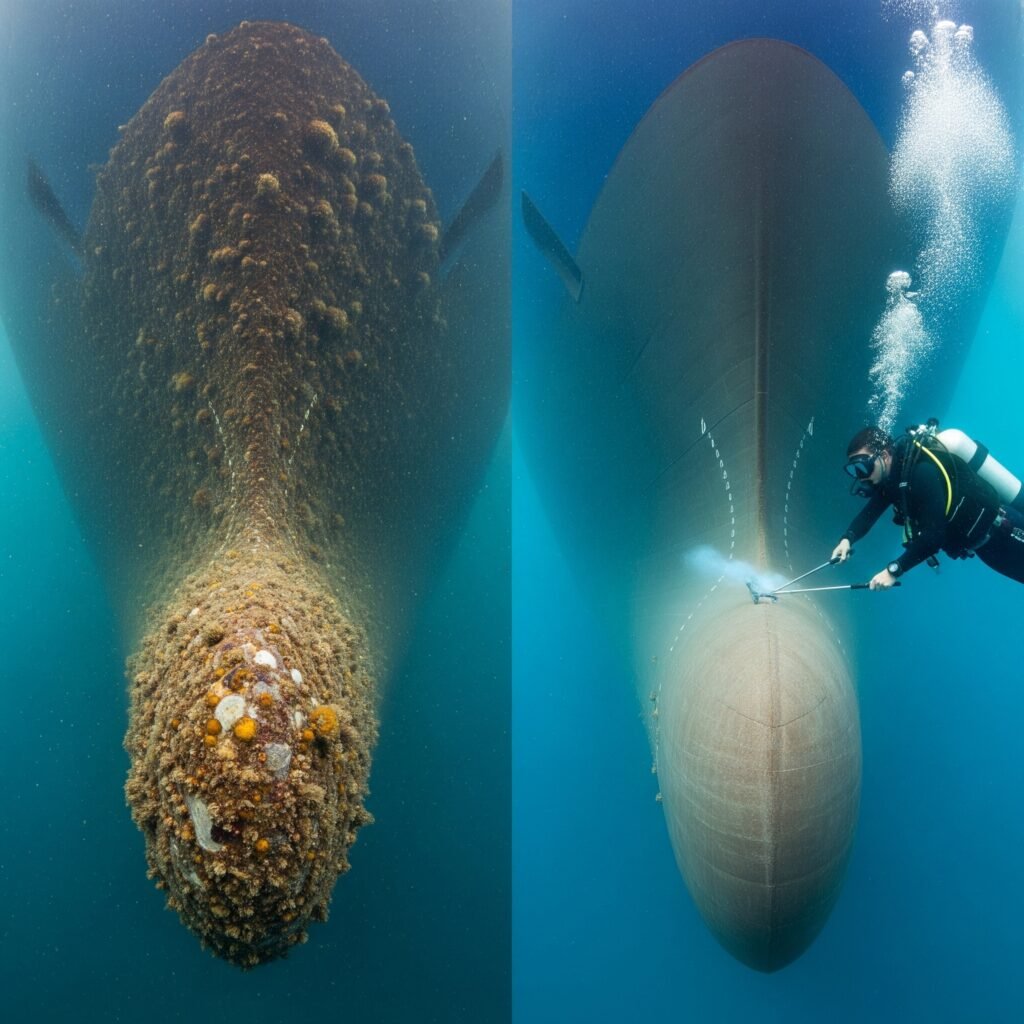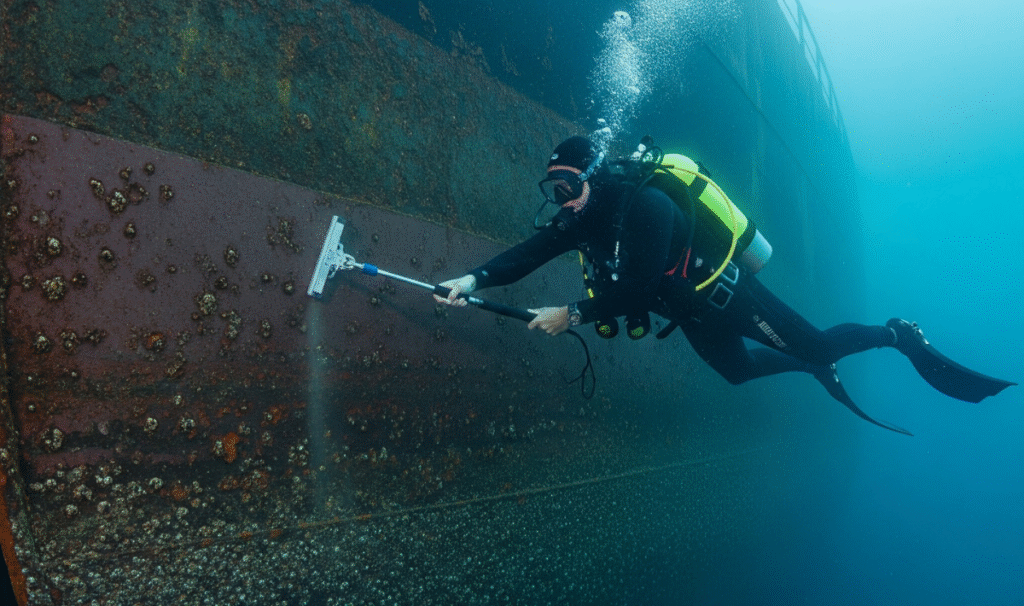When you think of Namibia, maybe your mind paints a canvas of sweeping deserts, the Skeleton Coast, and rolling dunes colliding with the sea. But beneath those waves, Namibia hides another story—one of ports, global trade routes, and maritime potential.
Walvis Bay and Lüderitz, Namibia’s key ports, have become buzzing stopovers for vessels connecting Africa with Europe, Asia, and the Americas. Ships that pass through these waters depend not only on fueling and repairs but also on an often overlooked yet crucial service: underwater ship hull cleaning in Namibia.
This practice, far more than scrubbing barnacles away, contributes to fuel savings, vessel durability, and protection of our oceans. Let’s dive deeper (pun fully intended!) into the underwater ship hull cleaning in Namibia—and why this African nation is becoming a serious maritime destination.
What is Underwater Ship Hull Cleaning in Namibia?
Think of your vessel’s hull like an athlete’s swimwear. When it’s brand new, sleek, and smooth, each stroke cuts effortlessly through the water. But over time, imagine algae, barnacles, and slime sticking to every inch, similar to a wet blanket dragging that athlete back. That’s what biofouling does to ships.
In essence, hull cleaning removes this slimy buildup. In Namibia, trained divers or sophisticated machines work underwater using brushes, cavitation jets, and suction tools to scrub ships clean without harming protective coatings. The result? A smoother hull, reduced drag, and a ship performing as efficiently as it was built to.
How Biofouling Wastes Energy
Picture driving with mud-caked tires—it takes more effort to roll forward. Now stretch that friction across thousands of tons of cargo ships. Even a thin layer of barnacles can increase fuel use by 20–30%, according to maritime studies.
Every extra ton of fuel burned drains profits and increases emissions. Biofouling doesn’t just slow vessels down; it empties wallets.

Fuel Efficiency Gained Through Clean Hulls
With underwater ship hull cleaning in Namibia, vessels glide more freely. A smoother hull means higher speeds at lower engine power, slashing bunker fuel costs—one of the shipping industry’s biggest expenses.
For operators, the payoff is quick. Regular cleaning schedules in Namibia often lead to significant operational savings, making this service less of an expense and more of a smart investment.
Corrosion Prevention and Structural Integrity
Marine organisms cling stubbornly to vessel hulls, locking in moisture. This accelerates corrosion and weakens protective coatings. Over time, unchecked biofouling compromises the integrity of the hull, threatening vessel safety.
Cleaning is like preventive healthcare for ships. By removing biofouling early, operators protect hull structure, delay costly repairs, and extend vessel lifespan.
Compliance with International Safety Standards
Maritime rules are strict. The IMO sets global safety requirements, and hull inspections are part of the drill. Failing due to fouling means delays, fines, or even being grounded.
With routine underwater ship hull cleaning in Namibia, operators ensure compliance, pass checks, and keep voyages on schedule—all while improving safety at sea.
Reducing Greenhouse Gas Emissions
Did you know that shipping contributes nearly 3% of the world’s greenhouse gas emissions? According to imo.org, smoother hulls equal lower emissions. Every ton of fuel saved reduces tons of CO₂ released into our fragile atmosphere.
Ships opting for underwater ship hull cleaning in Namibia are not just saving money—they’re contributing to climate goals, one hull at a time.
Preventing the Spread of Invasive Species
The MARPOL Convention highlights how ships unintentionally transport marine organisms across regions. An invasive species hitchhiking from South America to Africa could wreak havoc on Namibia’s rich coastal ecosystems.
Regular hull cleaning prevents such biological invasions, preserving Namibia’s unique marine environment and biodiversity.
Geographical Advantage Along Shipping Routes
Namibia sits along vital Atlantic shipping corridors. Ports like Walvis Bay make it an ideal pit stop for maintenance services such as underwater ship hull cleaning in Namibia, avoiding unnecessary detours for ocean-crossing vessels.
Experienced Divers and Modern Facilities
Namibia’s marine sector is growing fast. Skilled divers, trained in international best practices from imca-int.com, and advanced port infrastructure ensure professional, eco-conscious cleaning.
Plus, organizations like iaphworldports.org stress Namibia’s emerging importance in the global maritime network.
Step-by-Step Cleaning Process
- Inspection – Divers assess biofouling levels and hull condition.
- Cleaning – Specialized brushes, water jets, or cavitation devices remove buildup.
- Polishing – Restores hydrodynamic smoothness.
- Debris Management – Responsible collection of removed material.
- Final Check – Ensures coating integrity and compliance.
Modern Technology and Tools in Namibia
Namibia is embracing innovations like remotely operated vehicles (ROVs) and eco-friendly filtration systems that minimize waste and environmental harm. These tools enhance efficiency while safeguarding oceans.
Frequency vs. Cost Considerations
Clean too often and you risk damaging protective coatings. Delay too much and biofouling skyrockets, negating benefits. The balance? Many experts recommend hull cleaning every 6–12 months, depending on trade routes.
For ships on extended stops, regular underwater ship hull cleaning in Namibia helps maintain optimal performance.
Namibia’s Local Environmental Factors
The Atlantic waters off Namibia are rich in nutrients, encouraging marine growth year-round. While this fosters vibrant ecosystems, it also means ship hulls foul faster—making maintenance services increasingly vital here.

Eco-Friendly Innovations
The global push for sustainability is driving innovations, from antifouling paints free of harmful biocides to advanced cleaning robots. Namibia is well-positioned to adopt these technologies, boosting both efficiency and environmental stewardship.
Robotics and AI for Smarter Maintenance
Imagine AI systems monitoring hull smoothness in real-time, notifying operators when cleaning is needed—not too early, not too late. Soon, robotic cleaners could swim autonomously, performing underwater ship hull cleaning in Namibia with zero human risk.
Conclusion
Ships carry the lifeblood of global trade, but without proper hull care, efficiency sinks and costs surge. Regular underwater ship hull cleaning in Namibia highlights the importance of this essential service:
- Fuel and cost savings through reduced drag.
- Longer vessel life and enhanced safety with corrosion prevention and compliance.
- Environmental sustainability by lowering emissions and protecting ecosystems.
With its strategic Atlantic location, skilled workforce, and growing infrastructure, Namibia is emerging as a key maritime hub. By partnering with experts like CleanShip.co, shipowners secure efficiency, sustainability, and long-term success.
FAQ:
Q1. How often should ships schedule underwater hull cleaning in Namibia?
Typically, every 6–12 months, though biofouling growth rates depend on operational waters.
Q2. Is hull cleaning safe for protective coatings?
Yes, when performed by certified professionals using modern equipment.
Q3. Does underwater cleaning really reduce emissions?
Absolutely. By cutting drag, ships burn less fuel and therefore release fewer greenhouse gases.
Q4. Why is Namibia an emerging maritime hub?
Its ports are strategically located along Atlantic routes, with modern facilities and trained divers.
Q5. Are invasive species a major concern in Namibia?
Yes. Hitchhiking organisms can disrupt ecosystems. Regular hull cleaning prevents this ecological threat.


